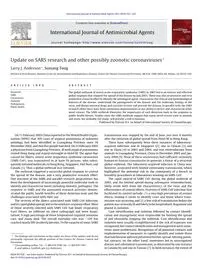
2010 Update on SARS research and other possibly zoonotic coronaviruses PDF
Preview 2010 Update on SARS research and other possibly zoonotic coronaviruses
International Journal of Antimicrobial Agents 36S (2010) S21–S25 Contents lists available at ScienceDirect International Journal of Antimicrobial Agents journal homepage: http://www.elsevier.com/locate/ijantimicag Update on SARS research and other possibly zoonotic coronaviruses� Larry J. Anderson ∗, Suxiang Tong Division of Viral Diseases, National Center for Immunization and Respiratory Diseases, Centers for Disease Control and Prevention, MS A34, 1600 Clifton Rd, Atlanta, GA 30333, USA a r t i c l e i n f o Keywords: SARS Coronavirus Zoonosis Pathogenesis Public health a b s t r a c t The global outbreak of severe acute respiratory syndrome (SARS) in 2003 led to an intense and effective global response that stopped the spread of the disease by July 2003. There was also an intensive and very productive research effort to identify the aetiological agent, characterise the clinical and epidemiological features of the disease, understand the pathogenesis of the disease and the molecular biology of the virus, and design antiviral drugs and vaccines to treat and prevent the disease. In parallel with the SARS research effort there have been continuous improvements in our ability to detect and characterise other novel viruses. The SARS outbreak illustrates the importance of such detection tools in the response to public health threats. Studies since the SARS outbreak suggest that many novel viruses exist in animals and some, but probably not many, will present a risk to humans. Published by Elsevier B.V. on behalf of International Society of Chemotherapy. On 11 February 2003 China reported to the World Health Organ- isation (WHO) that 305 cases of atypical pneumonia of unknown aetiology had been identified in Guangdong Province since 16 November 2002, and that five people had died. On 21 February 2003 a physician from Guangdong Province, ill with atypical pneumonia, visited Hong Kong and stayed overnight in Hotel M. The agent that caused his illness, severe acute respiratory syndrome coronavirus (SARS CoV), was transmitted to at least 10 persons, who subse- quently initiated outbreaks in Hong Kong, Singapore, Viet Nam, and Canada [1]. Thus a global outbreak was initiated. The outbreak triggered a successful global response to control the spread of the disease, and a very productive research effort. One outcome of the SARS and parallel research programmes has been the development of increasingly powerful molecular tools to identify and characterise novel, including zoonotic, pathogens. The response to SARS and the associated research activities demon- strated the public health benefits of these detection tools and the challenges associated with their use. The severity of the illness associated with SARS CoV infection, and its rapid global spread, led to the intensive response effort. Most of those severely infected with SARS CoV had lower respiratory tract illness, an infiltrate on chest radiograph and were hospi- talised. A high percentage of those hospitalised required intensive care, and many died. The overall mortality rate was ∼10% but reached nearly 50% in elderly persons. To the surprise of some, SARS � The findings and conclusions in this report are those of the authors and do not necessarily represent the official position of the Centers for Disease Control and Prevention. ∗ Corresponding author. Tel.: +1 404 639 3596; fax: +1 404 639 1307. E-mail address:
